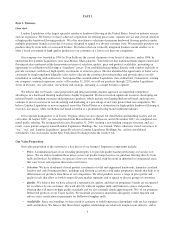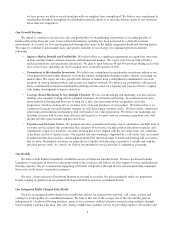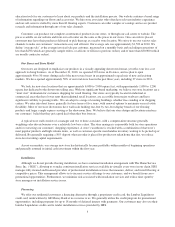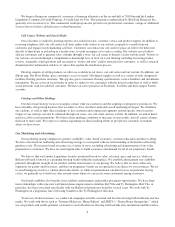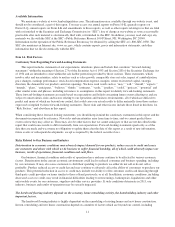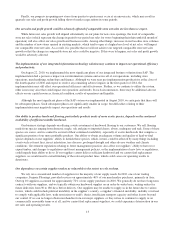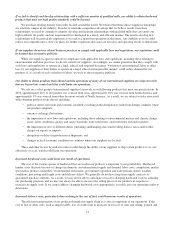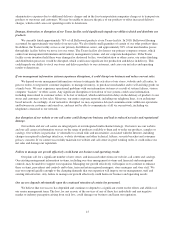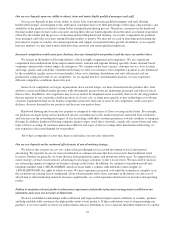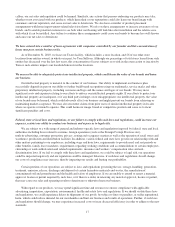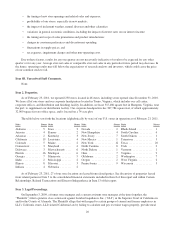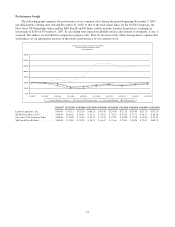Lumber Liquidators 2010 Annual Report Download - page 19
Download and view the complete annual report
Please find page 19 of the 2010 Lumber Liquidators annual report below. You can navigate through the pages in the report by either clicking on the pages listed below, or by using the keyword search tool below to find specific information within the annual report.Finally, our progress in opening new stores from quarter to quarter may occur at an uneven rate, which may result in
quarterly net sales and profit growth falling short of market expectations in some periods.
Our net sales and profit growth could be adversely affected if comparable store net sales are less than we expect.
While future net sales growth will depend substantially on our plans for new store openings, the level of comparable
store net sales (which represent the change in period-over-period net sales for stores beginning their thirteenth full month of
operation) will also affect our sales growth and business results. Among other things, increases in our baseline store volumes
and the number of new stores opened in existing markets, which tend to open at a higher base level of net sales, will impact
our comparable store net sales. As a result, it is possible that we will not achieve our targeted comparable store net sales
growth or that the change in comparable store net sales could be negative. If this were to happen, net sales and profit growth
would be adversely affected.
The implementation of our integrated information technology solution may continue to impact our operational efficiency
and productivity.
On August 22, 2010, we implemented the most significant phase of our integrated business solution from SAP. The
implementation had a pervasive impact on our information systems and across all of our operations, including store
operations, merchandising, technology and finance. Although we were near pre-implementation productivity at the close of
the fourth quarter of 2010 and expect to resolve any remaining adverse impacts in the first quarter of 2011, the
implementation may still affect our operational efficiency and effectiveness. Further, as we continue to utilize the system,
other issues may arise that could impact our operations and results. In such circumstances, there may be additional adverse
effects on our capital resources, financial condition, results of operations and liquidity.
Although the most significant phase of the SAP system was implemented in August 2010, we anticipate that there will
be subsequent phases. Such subsequent phases are significantly smaller in scope, but difficulties relating to their
implementation may negatively impact our operations and results.
Our ability to produce hardwood flooring, particularly products made of more exotic species, depends on the continued
availability of sufficient suitable hardwood.
Our business strategy depends on offering a wide assortment of hardwood flooring to our customers. We sell flooring
made from species ranging from domestic maple, oak and pine to imported cherry, ebony, mahogany and teak. Some of these
species are scarce, and we cannot be assured of their continued availability, especially of exotic hardwoods that comprise a
significant portion of our more profitable products. Our ability to obtain an adequate volume and quality of hard-to-find
species depends on our suppliers’ ability to furnish those species, which, in turn, could be affected by many things including
events such as forest fires, insect infestation, tree diseases, prolonged drought and other adverse weather and climate
conditions. Government regulations relating to forest management practices also affect our suppliers’ ability to harvest or
export timber, and changes to regulations and forest management policies, or the implementation of new laws or regulations,
could impede their ability to do so. If our suppliers cannot deliver sufficient hardwood and we cannot find replacement
suppliers, we would need to curtail finishing of the relevant product lines, which could cause our operating results to
deteriorate.
Our dependence on certain suppliers makes us vulnerable to the extent we rely on them.
We rely on a concentrated number of suppliers for the majority of our supply needs. In 2010, one of our trading
companies, Sequoia Floorings, provided services on approximately 40% of our merchandise purchases, primarily in Asia.
Our top 10 suppliers accounted for approximately 72% of our supply purchases in 2010. We generally do not have long-term
contracts with our suppliers, and we typically obtain our hardwood supplies on an order-by-order basis, writing orders for
future deliveries from 90 to 180 days before delivery. Our suppliers may be unable to supply us in the future due to various
factors, which could include political instability in the supplier’s country, a supplier’s financial instability, inability or refusal
to comply with applicable laws, trade restrictions or tariffs, duties, insufficient transport capacity and other factors beyond
our control. If we can no longer obtain merchandise from our major suppliers, or they refuse to continue to supply us on
commercially reasonable terms or at all, and we cannot find replacement suppliers, we could experience deterioration in our
net sales and operating results.
13


